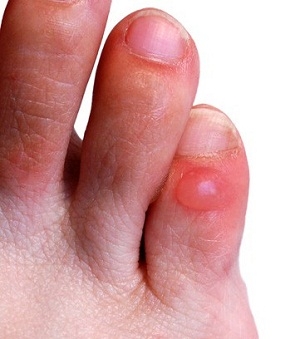Water callus delivers not only pain and inconvenience in everyday life, but can also become a kind of gateway for the penetration of staphylococcal infection with further inflammation and the development of serious complications. Calluses on the feet occur most often, and they are caused by uncomfortable shoes or high loads when walking or during sports activities. But also on the hands of water calluses – not uncommon, since the skin on the palms is tender and sensitive, it is damaged when peeling vegetables with wet hands, and when squeezing a tennis racket with a sweaty palm. In any case, water callus requires careful treatment so that severe inflammation does not occur in its place.
The nature of the manifestation of water calluses and the main causes
 The main cause of water calluses – this is friction, tight contact of the skin with tissue or other objects, in which the surface layer of the skin, as it were, shifts relative to the deeper layers. In this case, the skin layer is peeled off and a cavity is formed under it, which is immediately filled with intercellular fluid – water callus is formed on the friction area.
The main cause of water calluses – this is friction, tight contact of the skin with tissue or other objects, in which the surface layer of the skin, as it were, shifts relative to the deeper layers. In this case, the skin layer is peeled off and a cavity is formed under it, which is immediately filled with intercellular fluid – water callus is formed on the friction area.
The appearance of water calluses is promoted by the factor of increased humidity, in which the contact of the skin with a foreign object or with clothing becomes especially close. Calluses on the feet can be triggered not only by tight shoes, but also by excessive sweating of the feet or by wearing synthetic socks that increase perspiration and moisturize the skin. Water calluses on the hands arise from scissors, knives, and other objects that are taken in a wet palm, as well as from a tennis racket, a shovel, and other tools that are compressed by a sweaty palm.
In the area of friction, the skin first turns red and swells a little, it worries with slight soreness. Later, a bubble is formed in this place with a clear liquid – water callus. The tension of the walls of the bladder causes severe pain, the bladder can be large, there is a scattering of small bubbles. From touching the water callus, the pain intensifies, with mechanical damage, the wall may burst and the liquid may leak out. Sometimes, when the bladder is injured, its walls come off completely, and a red, inflamed, weeping spot remains in place of the water callus.
Treatment of water callus and prevention of complications
If the calluses on the feet are very small, do not hurt and do not burst, then this type of water callus does not require special treatment – it should simply be covered with a band-aid to prevent injury.
It is recommended to pierce a water callus of large size and with severe pain to prevent rupture of the walls. The puncture is carried out with a sterile instrument – on the side, in no case from above, so as not to damage the bottom of the corn. Water callus is pre-treated with a disinfectant. After the release of the liquid, the corn is tightly covered with a sterile absorbent napkin, then an antibiotic ointment and a protective patch. Sometimes, after a while, the water callus can fill up with liquid again, and then a new puncture will be required. The most favorable time for such a procedure – the first day after the formation of the bubble.
In case of spontaneous opening of the water callus, especially with the detachment of the walls, the wound is disinfected, cleaned, covered with a gauze pad with antibacterial ointment and a band-aid. If the contents of the bladder become cloudy, the patient complains of severe pain, a rise in temperature, and the skin around the water callus turns red, yellowish crusts appear – means a bacterial infection has joined the process. Such inflammation requires opening and draining the bladder, prescribing antibiotic therapy.







Add a comment